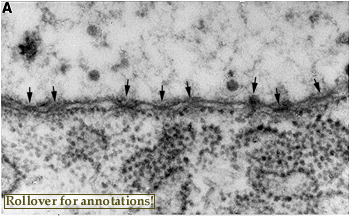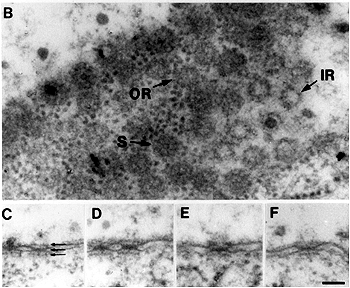Electron Microscopy: Nuclear EnvelopeA. An electron micrograph showing the nuclear envelope in an "edge on" view. The nucleus is at the top and the cytoplasm at the bottom. The inner and the outer membrane of the nuclear envelope may be seen as two parallel lines in the middle of the image. At the nuclear pore complexes (NPCs) , denoted with arrows the two membranes appear to fuse together. |
 |
 |
|
B. An electron micrograph showing the nuclear envelope in a "face on" view. From this angle the NPCs are seen as round circles. The eight-fold symmetry can be detected. The thickness of the section is less that the size of the NPC and the different parts of the NPC are therefore visible separately. OR denotes the outer ring facing the cytoplasm, S the spoke assembly of the annular subunits, and IR the inner ring facing the nucleus. C-F. Four NPCs in the same view
as in fig A above. The three arrows denote the inner
ring facing the nucleoplasm, the spoke assembly of
the annular subunits and the outer ring facing the
cytoplasm. Due to the thickness of the section, the
structures are superimposed and the hole at the
center of the pore is not visable. Acknowledgement: Reproduced from "Structural Interaction between the Nuclear Pore Complex and a Specific Translocating RNP Particle", Hans Mehlin, Bertil Daneholt and Ulf Skoglund, J. Cell Biol. 1995; 129:1205-1216 by kind copyright permission of The Rockefeller University Press. |